Hyperoliidae
Sedge and Bush Frogs
David Cannatella- Hyperoliinae
- Callixalus
- Chrysobatrachus
- Cryptothylax
- Heterixalus
- Hyperolius
- Opisthothylax
- Tachycnemis
- Kassininae
- Afrixalus
- Kassina
- Kassinula
- Phlyctimantis
- Tornierella
- Leptopelinae
- Acanthixalus
- Leptopelis
Introduction
Hyperoliids are the Sedge and Bush Frogs of Africa, Madagascar, and Seychelles Islands. The genus Hyperolius (Reed and Lily frogs) has more than 100 species of small, often brightly colored and polymorphic species. The genus Kassina has medium-sized species that prefer to walk and even run in place of hopping. Leptopelis tend to be more properly "tree" frogs, whereas Hyperolius frequent sedges and rushes. Tornierella are specialized snail-eaters (Drewes and Roth, 1981). There are three subfamilies: Hyperoliinae, Kassininae, and Leptopelinae.Discussion of Phylogenetic Relationships
Ford and Cannatella (1993) defined Hyperoliidae as the node-based name for the common ancestor of the hyperoliid taxa listed in Duellman and Trueb (1986:547) (Acanthixalus, Afrixalus, etc.), and all of its descendants. The two synapomorphies listed by Drewes (1984) were the lack of fusions of the second distal carpal and second tarsal elements, a condition he considered paedomorphic; these were not shared with any ranids. As discussed above, Laurent's data on these characters differed. Channing (1989) reanalyzed Drewes' (1984) data (slightly modified) on hyperoliids and a subset of Liem's (1970) data on hyperoliids and rhacophorids (including mantellines). Channing concluded that hyperoliids and rhacophorids (including mantellines) were each monophyletic and that they were sister-groups. However, given that he included no ranids in his analysis, Channing would be unable to demonstrate that they were not each others' closest relatives, even if one were paraphyletic with respect to the other.
Channing's re-analysis of Drewes' (1984) data assumed monophyly of Hyperoliidae, so synapomorphies were not listed. Channing's (1989:Fig. 1) analysis of Liem's (1970) combined data on hyperoliids and rhacophorids yielded 13 synapomorphies of Hyperoliidae including (1) presence of a dentomentalis muscle, (2) absence of a nuptial pad, (3) claw-shaped terminal phalanges, (4) absence of the posterolateral process of the hyoid, (5) vertical pupil, and (6) a cartilaginous sternum. Drewes (1984) did not examine characters 1 and 2, differed from Channing in the description of character 3, and indicated that characters 4, 5, and 6 were present in a more inclusive clade, including arthroleptines and astylosternines. Because Channing used "ranids" as the outgroup, without discriminating states in arthroleptines and astylosternines from other ranids, the number of synapomorphies for Hyperoliidae is likely inflated.
Duellman and Trueb (1986) used the presence of three tarsalia (unfused second tarsal; character Q) to unite hyperoliids and mantellines. However, Liem (1970) stated that the second tarsal was fused in all mantellines examined (three species of Mantidactylus and one of Aglyptodactylus). However, he indicated the second carpal was not fused in these taxa, a feature shared with hyperoliids.
Additional Photographs

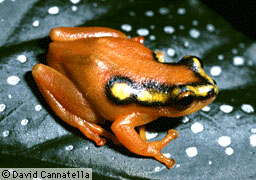
Hyperolius puncticulatus; photo © David Cannatella

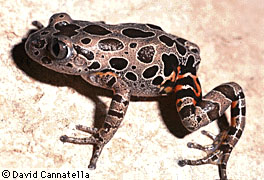
Kassina maculata; photo © David Cannatella
References
Click here for general list of references
Title Illustrations

1. Hyperolius sp.; photo © 1995 David Cannatella
2. Kassina sp.; photo © David Cannatella
| Copyright |
© 1995 David Cannatella

|
|---|
| Copyright |
© 1995 David Cannatella

|
|---|
About This Page
David Cannatella

University of Texas, Austin, Texas, USA
Correspondence regarding this page should be directed to David Cannatella at
Page copyright © 1995 David Cannatella
 Page: Tree of Life
Hyperoliidae. Sedge and Bush Frogs.
Authored by
David Cannatella.
The TEXT of this page is licensed under the
Creative Commons Attribution License - Version 3.0. Note that images and other media
featured on this page are each governed by their own license, and they may or may not be available
for reuse. Click on an image or a media link to access the media data window, which provides the
relevant licensing information. For the general terms and conditions of ToL material reuse and
redistribution, please see the Tree of Life Copyright
Policies.
Page: Tree of Life
Hyperoliidae. Sedge and Bush Frogs.
Authored by
David Cannatella.
The TEXT of this page is licensed under the
Creative Commons Attribution License - Version 3.0. Note that images and other media
featured on this page are each governed by their own license, and they may or may not be available
for reuse. Click on an image or a media link to access the media data window, which provides the
relevant licensing information. For the general terms and conditions of ToL material reuse and
redistribution, please see the Tree of Life Copyright
Policies.
Citing this page:
Cannatella, David. 1995. Hyperoliidae. Sedge and Bush Frogs. Version 01 January 1995 (under construction). http://tolweb.org/Hyperoliidae/16959/1995.01.01 in The Tree of Life Web Project, http://tolweb.org/




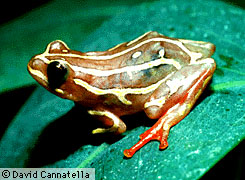
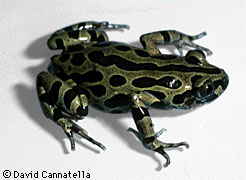

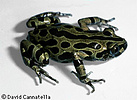


 Go to quick links
Go to quick search
Go to navigation for this section of the ToL site
Go to detailed links for the ToL site
Go to quick links
Go to quick search
Go to navigation for this section of the ToL site
Go to detailed links for the ToL site